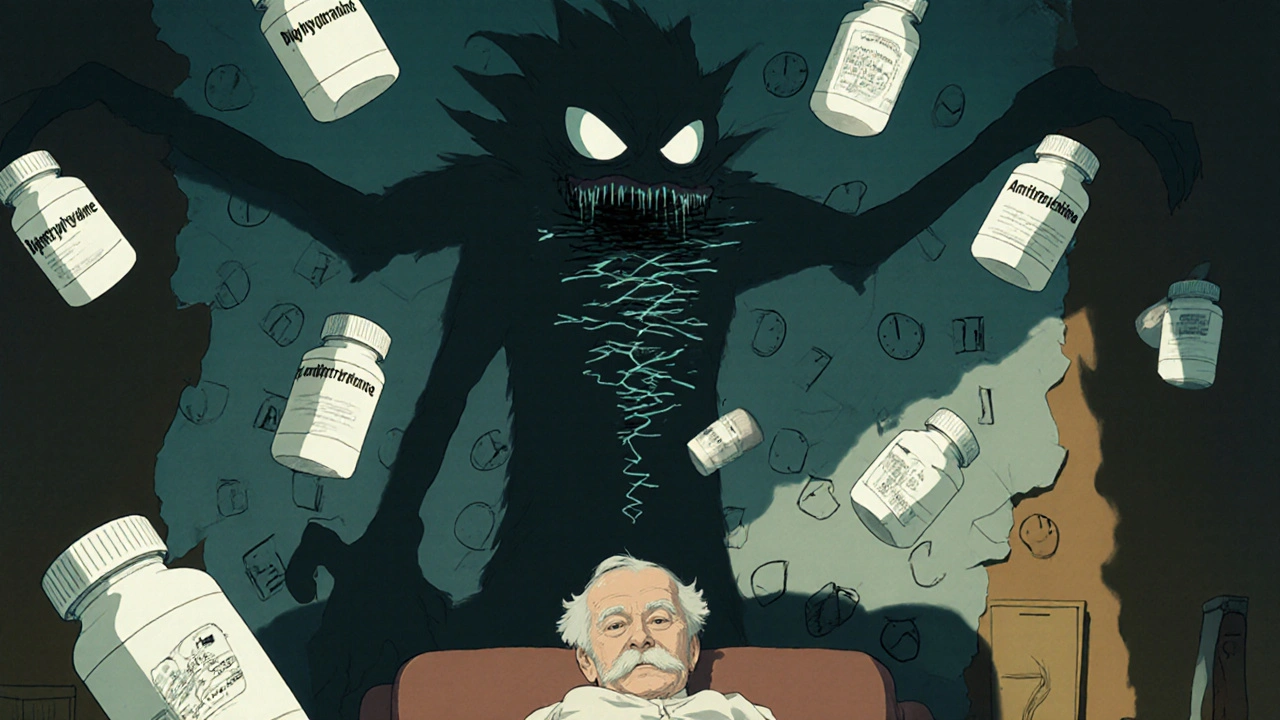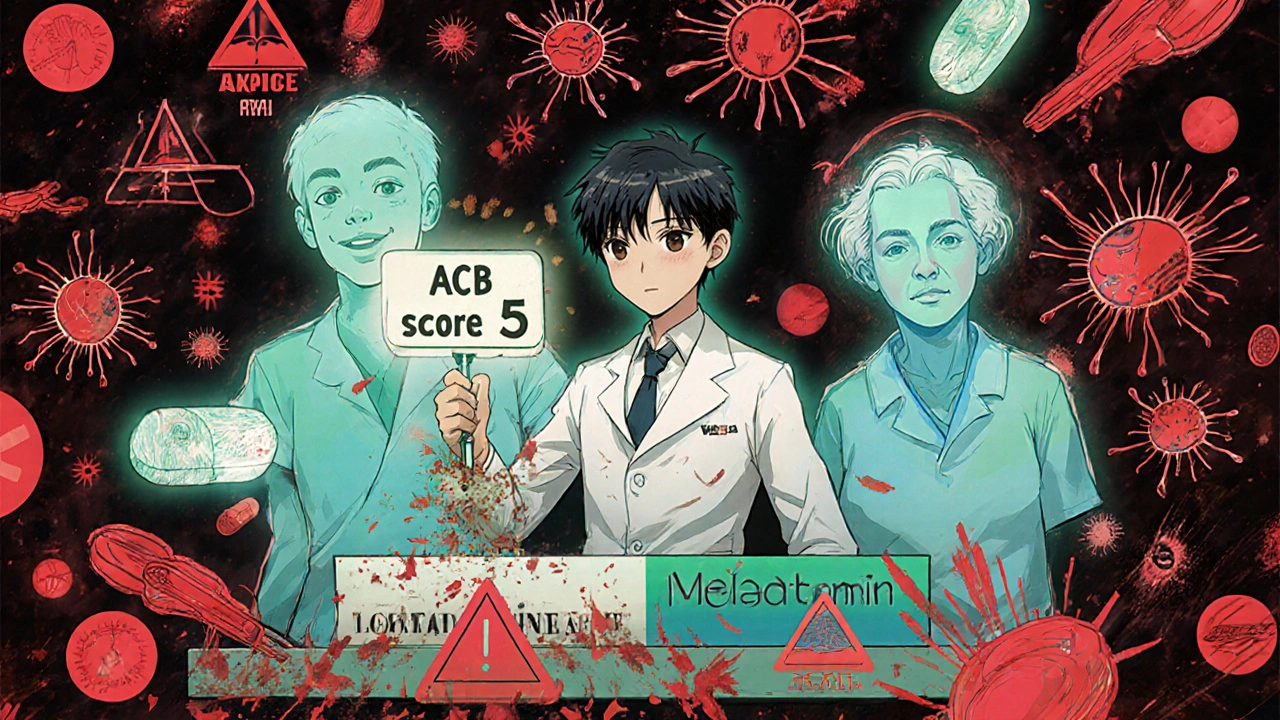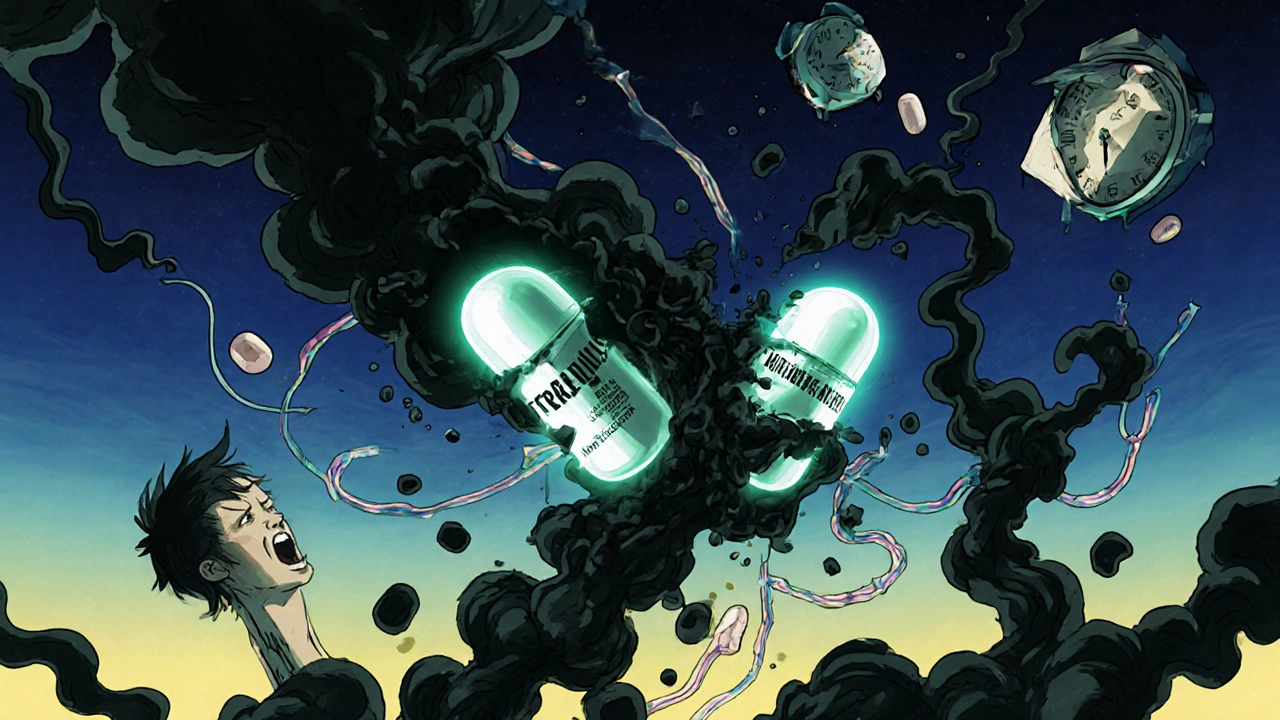Anticholinergic Burden Calculator
Assess Your Medication Risk
Risk Assessment
ACB score of indicates risk of:
- Confusion and delirium
- Memory impairment
- Urinary retention
- Increased dementia risk
Safer Alternatives
Combining tricyclic antidepressants (TCAs) with first-generation antihistamines might seem harmless-after all, both are commonly prescribed. One helps with depression or chronic pain, the other with allergies or sleep. But together, they can push your body into a dangerous state called anticholinergic overload. This isn’t a rare side effect. It’s a predictable, preventable crisis that’s quietly affecting thousands of older adults every year.
What Is Anticholinergic Overload?
Your body uses acetylcholine, a key neurotransmitter, to control everything from memory and attention to bladder function and heart rate. Anticholinergic drugs block this chemical. A single drug might cause mild dry mouth or drowsiness. But when two or more anticholinergic medications are taken together, the effects pile up. That’s anticholinergic overload.Tricyclic antidepressants like amitriptyline (Elavil), clomipramine (Anafranil), and imipramine (Tofranil) were developed in the 1950s. They work by increasing serotonin and norepinephrine-but they also strongly block muscarinic receptors, the same ones targeted by anticholinergic drugs. First-generation antihistamines like diphenhydramine (Benadryl), hydroxyzine, and chlorpheniramine do the same thing. Even though they’re sold over the counter, they’re not safe to mix with TCAs.
The problem? These drugs don’t just add up-they multiply. A 2020 study in Elsevier found over 6,800 high-risk drug interaction alerts linked to TCA and antihistamine combinations. That’s not a glitch in the system. It’s a red flag that’s being ignored too often.
Why This Combination Is So Dangerous
It’s not just about feeling sleepy. Anticholinergic overload hits the brain hardest. Symptoms include:
- Severe confusion or delirium
- Memory loss that looks like dementia
- Difficulty urinating or urinary retention
- Fast heart rate, constipation, blurred vision
- Hallucinations or agitation
One patient on Psych Forums described being rushed to the ER after adding Benadryl to her amitriptyline for sleep. She ended up with urinary retention and confusion so bad her family thought she’d had a stroke. Her doctor hadn’t considered the interaction. She wasn’t elderly-just 58. But her body couldn’t handle the combined load.
Older adults are at the highest risk. Their kidneys and liver slow down with age, so drugs stick around longer. A 2015 JAMA Internal Medicine study found people taking multiple anticholinergic drugs had a 54% higher risk of developing dementia over 10 years. And it’s not just long-term use. Even a 30-day course of high-burden combinations can raise delirium risk by 200% in people over 65, according to 2023 research from the National Institute on Aging.
Which Drugs Are the Worst Offenders?
Not all antidepressants or antihistamines carry the same risk.
Among TCAs, amitriptyline is the biggest concern. It has a Ki value of 8.9 nM at the M1 muscarinic receptor-meaning it binds tightly and blocks acetylcholine powerfully. Clomipramine is similar. Nortriptyline and desipramine are slightly safer, but still carry moderate risk.
On the antihistamine side, diphenhydramine (Benadryl) is the most common culprit. It scores a 2 on the Anticholinergic Cognitive Burden (ACB) scale. Hydroxyzine (Atarax) and promethazine (Phenergan) are also high-risk. Meanwhile, second-generation antihistamines like loratadine (Claritin), cetirizine (Zyrtec), and fexofenadine (Allegra) score a 0. They barely touch acetylcholine receptors at all.
Here’s how the burden adds up:
| Medication | Class | ACB Score | Risk Level |
|---|---|---|---|
| Amitriptyline | TCA | 3 | High |
| Diphenhydramine (Benadryl) | 1st-gen antihistamine | 2 | High |
| Clomipramine | TCA | 3 | High |
| Hydroxyzine | 1st-gen antihistamine | 2 | High |
| Loratadine (Claritin) | 2nd-gen antihistamine | 0 | Low |
| Cetirizine (Zyrtec) | 2nd-gen antihistamine | 0 | Low |
| Fluoxetine (Prozac) | SSRI | 0 | Low |
A combination of amitriptyline (3) and diphenhydramine (2) gives you a total ACB score of 5. Research shows that a score of 3 or higher is linked to increased dementia risk. A score of 5? That’s double the risk.

Why Do Doctors Still Prescribe This Combo?
It’s not ignorance. It’s convenience.
TCAs are still first-line for neuropathic pain, fibromyalgia, and some types of depression. Many patients need help sleeping. Diphenhydramine is cheap, available without a prescription, and widely believed to be harmless. Doctors often don’t realize that what they’re prescribing as a "sleep aid" is actually a powerful brain-altering drug.
A 2022 JAMIA study found that electronic health records now block 92% of attempted TCA-antihistamine prescriptions. But that still leaves 8% slipping through. Why? Because some clinicians override the alert. They assume the patient will be fine. Or they don’t know the alternatives.
And it’s not just primary care. Psychiatrists, pain specialists, and even ER doctors are involved. A resident on Reddit shared seeing three elderly patients admitted with delirium-all traced back to Benadryl added to a TCA by their family doctor. No one connected the dots.
What Should You Do Instead?
If you’re on a TCA and need help with allergies, sleep, or motion sickness, you have better options.
- Switch antihistamines: Use loratadine, cetirizine, or fexofenadine instead of Benadryl. They work just as well for allergies and don’t cross into the brain.
- For sleep: Try melatonin (0.5-5 mg), cognitive behavioral therapy for insomnia (CBT-I), or non-anticholinergic sleep aids like trazodone (low dose). Avoid doxylamine (Unisom) too-it’s just another anticholinergic.
- For pain: If you’re on amitriptyline for nerve pain, ask if nortriptyline or desipramine could work instead. They’re slightly safer.
- For depression: SSRIs like sertraline or escitalopram have far lower anticholinergic risk. Only use TCAs if other options have failed.
The American Geriatrics Society’s Beers Criteria (2023 update) explicitly says: "First-generation antihistamines should be avoided in older adults taking TCAs." This isn’t a suggestion. It’s a standard of care.

How to Check Your Own Risk
You don’t need to be a doctor to protect yourself.
- Make a list: Write down every medication you take, including over-the-counter pills and supplements.
- Check the ACB score: Look up each drug on the Anticholinergic Cognitive Burden scale. If any two or more have a score of 2 or higher, you’re at risk.
- Ask your pharmacist: Pharmacists are trained to catch these interactions. They see 37% of anticholinergic overload cases monthly, according to a 2021 American Geriatrics Society survey.
- Ask your doctor: "Is this combination safe for my brain?" If they hesitate, ask for alternatives.
And if you’re over 65, or have memory issues, even a single high-burden drug can be dangerous. Don’t assume it’s "just aging."
The Bigger Picture
This isn’t just about one bad combo. It’s about a system that treats medications like candy.
TCAs make up only 5% of antidepressant prescriptions today, down from 25% in 1990. But they’re still used for pain, sleep, and nausea-areas where safer options exist. Meanwhile, over 15,000 people searched for amitriptyline-Benadryl interactions on GoodRx in 2022. People are worried. They just don’t always know who to ask.
The FDA now requires updated labels on TCAs and first-gen antihistamines warning about cumulative anticholinergic effects. Pharmacies are catching more cases. And research shows that deprescribing these drugs can reverse cognitive decline by 34% in 18 months.
Change is coming. But it’s not fast enough.
Every time someone takes Benadryl with amitriptyline, they’re gambling with their memory. And most don’t even know they’re playing.
Can you take Benadryl with amitriptyline?
No, combining Benadryl (diphenhydramine) with amitriptyline significantly increases the risk of anticholinergic overload. Both drugs block acetylcholine, and together they can cause confusion, urinary retention, rapid heartbeat, and even delirium-especially in older adults. Safer alternatives include loratadine (Claritin) for allergies and melatonin for sleep.
What are the signs of anticholinergic toxicity?
Signs include severe confusion, memory loss, difficulty urinating, dry mouth, blurred vision, fast heart rate, constipation, and hallucinations. In older adults, these symptoms often look like dementia or a stroke. If you or someone you know starts showing these after starting or increasing a TCA or antihistamine, seek medical help immediately.
Are all antihistamines dangerous with TCAs?
No. Only first-generation antihistamines like diphenhydramine, hydroxyzine, and chlorpheniramine carry high anticholinergic risk. Second-generation antihistamines like loratadine (Claritin), cetirizine (Zyrtec), and fexofenadine (Allegra) have minimal effect on acetylcholine receptors and are safe to use with TCAs.
Can anticholinergic overload cause dementia?
Long-term use of multiple anticholinergic drugs is linked to a 54% increased risk of dementia, according to a 2015 JAMA study. Even short-term exposure in older adults can cause acute delirium that mimics dementia. Stopping these drugs can improve cognition-some patients show clear improvement within weeks.
What’s the safest antidepressant if I need to avoid anticholinergics?
SSRIs like sertraline, escitalopram, and fluoxetine have very low anticholinergic activity. SNRIs like venlafaxine and duloxetine are also safer options. TCAs like amitriptyline and clomipramine should only be used if other treatments fail, and never with first-gen antihistamines.
How can I tell if my medication has anticholinergic effects?
Check the Anticholinergic Cognitive Burden (ACB) scale. Drugs like amitriptyline and diphenhydramine score 3 and 2 respectively. You can search "ACB scale [drug name]" online or ask your pharmacist. If a drug causes drowsiness, dry mouth, or trouble peeing, it’s likely anticholinergic.
Next Steps
If you’re on a TCA and take an over-the-counter sleep or allergy aid, stop assuming it’s safe. Make an appointment with your doctor or pharmacist. Bring your full medication list-pills, patches, even herbal supplements.
If you’re caring for an older relative, check their medicine cabinet. Benadryl is often hidden in multi-symptom cold products. Look for "PM" versions of pain relievers-they usually contain diphenhydramine.
Anticholinergic overload isn’t a mystery. It’s a known, preventable danger. The tools to avoid it exist. The knowledge is out there. What’s missing is the urgency. Don’t wait for a hospital visit to realize the truth: sometimes, the safest medicine is the one you never took.









they told us benadryl was safe for sleep but now its a brain killer?? i mean i read this article and im like wait so every time i took it with my amitriptyline i was slowly turning into a zombie?? lol
oh my god this is so important!! i had my mom on benadryl for years and she started forgetting where she put her keys and then her doctor just said 'oh you're getting older'... nooo it was the meds!! thank you for posting this!! 💕
How anyone can still prescribe amitriptyline in the 21st century is beyond me. These are 1950s drugs for 1950s minds. If you're still on a TCA, you're not being treated-you're being experimented on. Second-gen antihistamines are free, effective, and don't turn your brain to mush. Why are we still living in the dark ages?
Let’s be real-this isn’t medical negligence, it’s pharmaceutical capitalism. The pharma giants don’t want you switching to loratadine because it’s generic and costs $3. They want you on $120/month amitriptyline + $20 Benadryl + $75/month cognitive therapy to fix the damage they caused. Wake up. This is a profit-driven massacre disguised as healthcare.
in india we dont even know what acb score is but i can tell u every old man here takes diphenhydramine with amitriptyline and they just call it normal sleep problem lol
This is such an eye-opener. I’ve been on nortriptyline for years and used Zyrtec for allergies-I had no idea I was avoiding the danger by accident. Thanks for the clarity. Really glad I checked.
Anticholinergic burden is a well-documented pharmacokinetic interaction with a clear dose-response curve. The ACB scale has been validated across multiple cohorts including the UK Biobank and the Health and Retirement Study. The 54% dementia risk increase is statistically significant at p<0.001. This isn't anecdotal-it's epidemiological fact.
If you're on a TCA and using OTC sleep aids, please don't feel guilty. You weren't trying to hurt yourself. You were just trying to sleep. Now that you know, you can make a safer choice. Your brain deserves better. And you're not alone-many of us are learning this together.
MY MOM WAS IN THE ER BECAUSE OF THIS AND NO ONE TOLD HER!! I FOUND OUT BY GOOGLEING AFTER SHE STOPPED BREATHING!! THIS IS A CRISIS AND NO ONE CARES!! 😭💊
It is imperative that healthcare professionals, particularly those prescribing psychotropic and antihistaminic agents, be thoroughly educated regarding cumulative anticholinergic burden. The American Geriatrics Society Beers Criteria, as well as the 2023 National Institute on Aging guidelines, provide clear, evidence-based directives which, if followed, would prevent a significant proportion of iatrogenic cognitive decline in elderly populations.
Just checked my meds-yep I had Benadryl and amitriptyline. Switched to Zyrtec last week and my brain feels clearer already. No more brain fog after lunch. Also my bladder stopped acting like a broken faucet. Small changes matter
Big shoutout to pharmacists-they’re the real MVPs here. My pharmacist caught this combo before I even realized it was a problem. They don’t just fill scripts-they save lives. Go talk to yours. Seriously.
Of course the system ignores this. People are disposable. The elderly? They’re just waiting for their turn. They’ll give you a new pill for the side effect of the last pill. It’s a revolving door of profit. You think they care if you forget your grandkids’ names? No. They care about your insurance co-pay.
Who even uses TCAs anymore? They’re outdated. If your doctor still prescribes amitriptyline, you need a new doctor. Period. And if you're taking Benadryl for sleep? You’re not sleeping-you’re chemically sedating your brain into a coma. Wake up.
i think the government is hiding this on purpose so old people die faster and social security costs go down